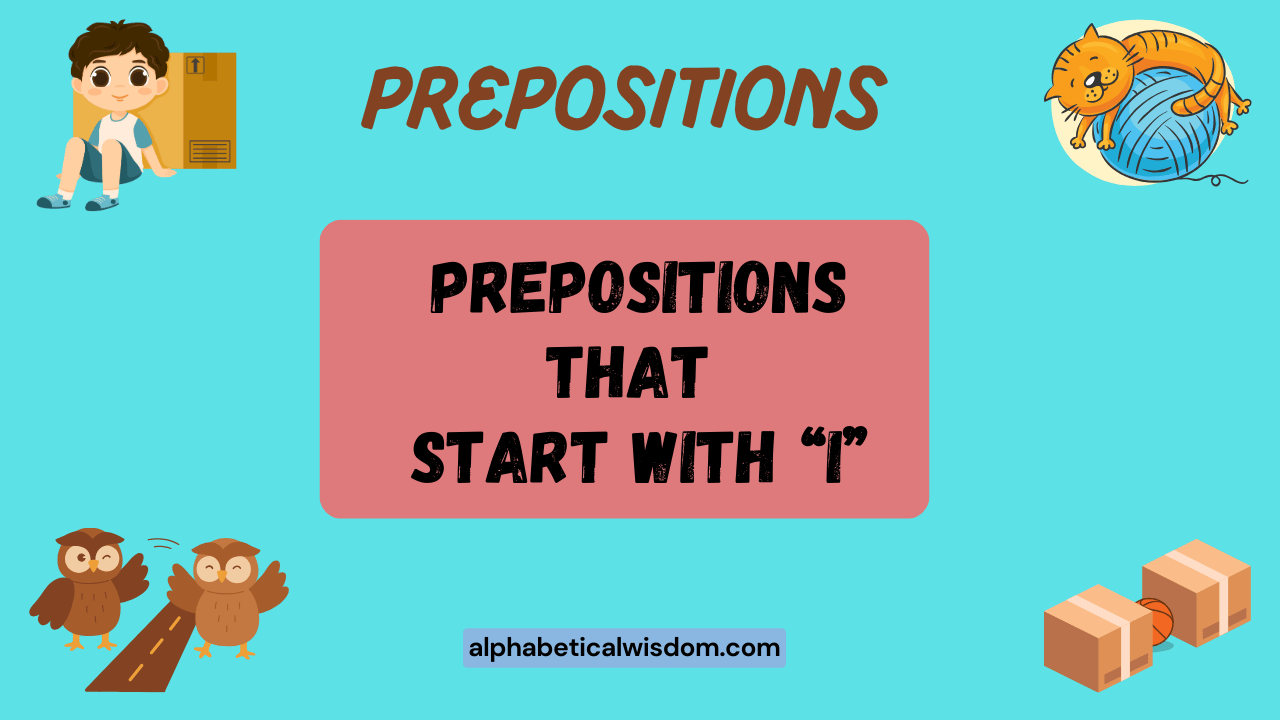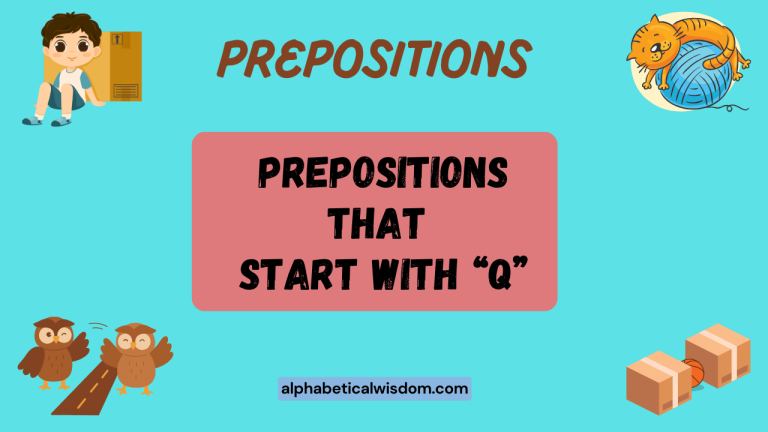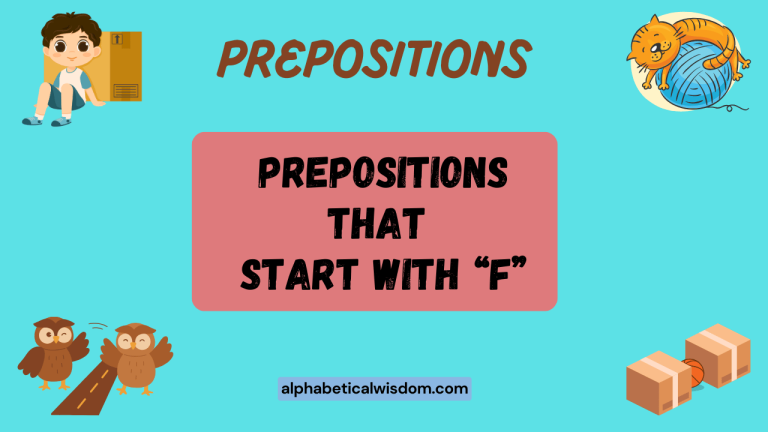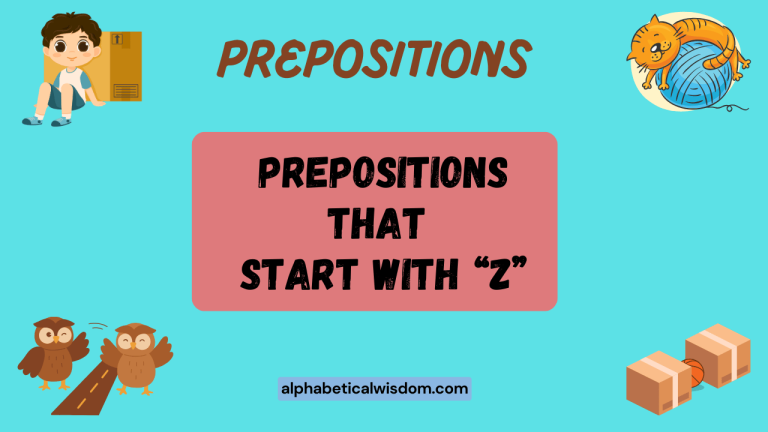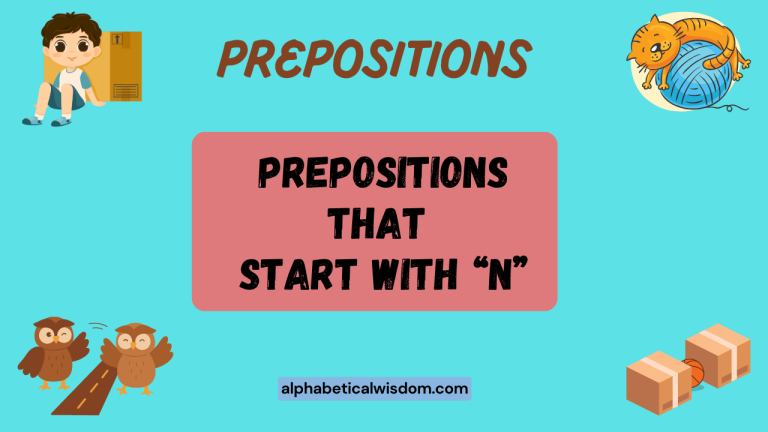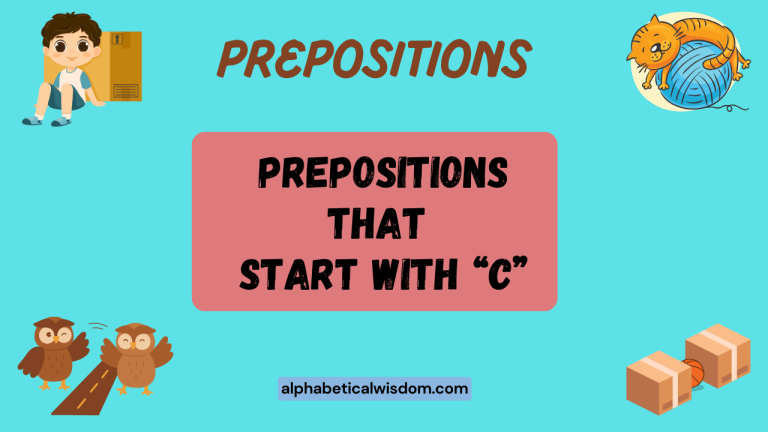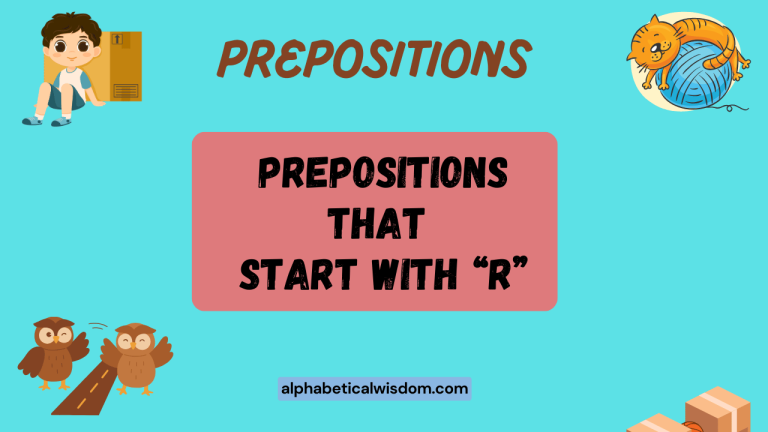Mastering Prepositions Starting With ‘I’: A Comprehensive Guide
Prepositions are essential components of English grammar, acting as bridges that connect nouns or pronouns to other words in a sentence. Understanding prepositions is crucial for constructing clear, coherent, and grammatically correct sentences.
While many prepositions are commonly used, this article focuses specifically on prepositions that begin with the letter ‘I’. Mastering these prepositions will enhance your ability to express spatial, temporal, and logical relationships with greater precision.
This guide is designed for English language learners of all levels, from beginners to advanced speakers, who seek to improve their understanding and usage of these often-overlooked yet vital words.
Table of Contents
- Introduction
- Definition of Prepositions
- Structural Breakdown of Prepositional Phrases
- Types and Categories of Prepositions Starting with ‘I’
- Examples of Prepositions Starting with ‘I’
- Usage Rules for Prepositions Starting with ‘I’
- Common Mistakes with Prepositions Starting with ‘I’
- Practice Exercises
- Advanced Topics
- Frequently Asked Questions (FAQ)
- Conclusion
Definition of Prepositions
A preposition is a word that connects a noun or pronoun (the object of the preposition) to other words in a sentence. It typically indicates the spatial, temporal, or logical relationship of the object to something else. Prepositions are essential for providing context and clarity to sentences, helping to establish connections between different elements. They frequently answer questions like “where?”, “when?”, or “how?”.
Prepositions can be classified based on their structure and function. Structurally, they can be simple (e.g., in, at, on), compound (e.g., according to, because of), or phrasal (e.g., in front of, on top of). Functionally, they can indicate location (e.g., in, on, at), time (e.g., at, on, in, before, after), direction (e.g., to, from, toward), or other relationships (e.g., of, for, with, by).
Understanding the different types and functions of prepositions is crucial for effective communication. By using prepositions correctly, speakers and writers can create clear and unambiguous sentences that accurately convey their intended meaning.
Misuse of prepositions, on the other hand, can lead to confusion and misinterpretation.
Structural Breakdown of Prepositional Phrases
A prepositional phrase consists of a preposition and its object, which is typically a noun or pronoun. The prepositional phrase functions as an adjective or adverb, modifying another word in the sentence. The basic structure of a prepositional phrase is:
Preposition + (Optional Modifiers) + Object (Noun/Pronoun)
Let’s break down this structure with examples:
- Preposition: in
- Object: the box
- Prepositional Phrase: in the box
In this example, “in” is the preposition, and “the box” is the object. The entire phrase “in the box” can function as an adverb, modifying a verb (e.g., “The cat is in the box“).
Prepositional phrases can also include modifiers, such as adjectives or adverbs, that describe the object of the preposition. For example:
- Preposition: inside
- Modifier: the old
- Object: house
- Prepositional Phrase: inside the old house
Here, “the old” modifies the noun “house,” providing more specific information about the location. The phrase “inside the old house” functions similarly to an adverb, describing where something is located.
The object of a preposition can also be a gerund (a verb acting as a noun). For example:
- Preposition: in
- Object (Gerund): reading
- Prepositional Phrase: in reading
In this case, “reading” is a gerund, and the phrase “in reading” can be used to describe a manner or condition (e.g., “She finds solace in reading“).
Types and Categories of Prepositions Starting with ‘I’
While the English language boasts a wide array of prepositions, relatively few begin with the letter ‘I’. The most commonly used prepositions starting with ‘I’ are “in”, “inside”, “into” and “onto”.
Each of these prepositions carries distinct meanings and usage patterns.
In
“In” is one of the most versatile prepositions in English. It is primarily used to indicate location within a defined space, time within a specific period, or inclusion within a particular category or condition.
It can denote a physical enclosure, a period of time, or a state of being.
Inside
“Inside” specifies a location within an enclosed space or container. It is more precise than “in” when emphasizing the enclosed nature of the location.
“Inside” can also refer to the inner part or contents of something.
Into
“Into” indicates movement or direction toward the interior of something. It suggests entry or transformation from an external state to an internal state.
“Into” often implies a change of location or condition.
Onto
“Onto” indicates movement or placement on the surface of something. It is used when an object is moved or placed upon another object.
It suggests attachment or covering.
Examples of Prepositions Starting with ‘I’
To illustrate the usage of prepositions starting with ‘I’, the following sections provide a range of examples for each preposition. These examples are organized into tables for clarity and ease of understanding.
Examples using “In”
The preposition “in” is used to describe locations, time periods, and states of being. The following table provides examples of its diverse applications.
| Category | Example Sentence |
|---|---|
| Location | The book is in the drawer. |
| Location | She lives in New York City. |
| Location | The fish are swimming in the pond. |
| Time | I was born in 1990. |
| Time | We will arrive in an hour. |
| Time | She completed the project in three days. |
| State/Condition | He is in good health. |
| State/Condition | The company is in debt. |
| State/Condition | They are in love. |
| Inclusion | The ingredient is in the recipe. |
| Inclusion | Her name is in the list. |
| Inclusion | The answer is in the book. |
| Abstract | I believe in honesty. |
| Abstract | He is interested in history. |
| Abstract | She specializes in marketing. |
| Clothing | She was dressed in a red dress. |
| Clothing | He looked smart in his suit. |
| Clothing | The baby was wrapped in a blanket. |
| Medium | The story was published in the newspaper. |
| Medium | The information is available in the database. |
| Medium | The movie is shown in 3D. |
| Shape | Cut the paper in half. |
| Shape | The cake was baked in the shape of a star. |
| Shape | The garden is laid out in a circle. |
| Activity | She excels in sports. |
| Activity | He is engaged in research. |
| Activity | They participate in community service. |
Examples using “Inside”
“Inside” is used to specify locations within enclosed spaces. It emphasizes the enclosed nature of the location.
| Category | Example Sentence |
|---|---|
| Location | The cat is sleeping inside the house. |
| Location | The temperature inside the car was very high. |
| Location | Let’s go inside the restaurant. |
| Figurative | He felt empty inside. |
| Figurative | She was smiling, but she was hurting inside. |
| Figurative | The truth is inside him. |
| Containers | There are cookies inside the jar. |
| Containers | The gift is hidden inside the box. |
| Containers | The money was inside the envelope. |
| Buildings | The meeting is taking place inside the building. |
| Buildings | We waited inside the airport. |
| Buildings | The exhibition is inside the museum. |
| Vehicles | We stayed inside the bus during the rain. |
| Vehicles | The children were playing inside the car. |
| Vehicles | The dog was barking inside the van. |
| Organs | The tumor was located inside the brain. |
| Organs | The infection spread inside the body. |
| Organs | The pain was deep inside his chest. |
| Enclosures | The animals are kept inside the zoo’s enclosure. |
| Enclosures | The garden is protected inside the walls. |
| Enclosures | The treasure was buried inside the cave. |
| Spacesuits | The astronaut was safe inside the spacesuit. |
| Spacesuits | The oxygen supply kept him alive inside the suit. |
| Spacesuits | He felt isolated inside the heavy spacesuit. |
Examples using “Into”
“Into” indicates movement or direction towards the interior of something or a change of state.
| Category | Example Sentence |
|---|---|
| Movement | She walked into the room. |
| Movement | The cat jumped into the box. |
| Movement | He drove into the city. |
| Transformation | The caterpillar turned into a butterfly. |
| Transformation | Water changes into ice. |
| Transformation | The prince was transformed into a frog. |
| Division | Cut the cake into slices. |
| Division | Divide the work into smaller tasks. |
| Division | The project was split into phases. |
| Engagement | She poured her heart into her work. |
| Engagement | He put all his energy into the game. |
| Engagement | They invested their savings into the business. |
| Collision | The car crashed into the wall. |
| Collision | The ship sailed into the iceberg. |
| Collision | The ball bounced into the net. |
| Investigation | The police looked into the matter. |
| Investigation | The committee delved into the details. |
| Investigation | The scientists researched into the causes. |
| Mixing | Mix the flour into the batter. |
| Mixing | Blend the fruits into a smoothie. |
| Mixing | Incorporate the sugar into the mixture. |
| Entering | He logged into his account. |
| Entering | She tapped into her potential. |
| Entering | They plugged into the power outlet. |
Examples using “Onto”
“Onto” indicates movement or placement on the surface of something.
| Category | Example Sentence |
|---|---|
| Placement | The cat jumped onto the table. |
| Placement | He placed the book onto the shelf. |
| Placement | She put the groceries onto the counter. |
| Attachment | The sticker was glued onto the paper. |
| Attachment | He fastened the buckle onto his belt. |
| Attachment | She sewed the patch onto the jacket. |
| Awareness | The responsibility fell onto his shoulders. |
| Awareness | The spotlight shone onto the stage. |
| Awareness | The pressure mounted onto the team. |
| Transfer | He transferred the data onto the hard drive. |
| Transfer | She uploaded the photos onto the website. |
| Transfer | They copied the files onto the USB drive. |
| Roads | The car drove onto the highway. |
| Roads | The cyclist rode onto the bike path. |
| Roads | The train moved onto the tracks. |
| Platforms | The actors walked onto the stage. |
| Platforms | The passengers boarded onto the plane. |
| Platforms | The speaker stepped onto the podium. |
| Applying | He put lotion onto his skin. |
| Applying | She spread butter onto the bread. |
| Applying | They applied paint onto the canvas. |
| Figurative | He held onto his dreams. |
| Figurative | She latched onto the opportunity. |
| Figurative | They clung onto hope. |
Usage Rules for Prepositions Starting with ‘I’
Understanding the specific rules for using “in,” “inside,” “into,” and “onto” is essential for accurate and effective communication. Each preposition has its own nuances and contexts in which it is most appropriate.
Failure to adhere to these rules can lead to confusion or misinterpretation.
“In” Usage Rules
“In” is used to indicate location within a space, time within a period, or inclusion within a category. Here are some key rules:
- Location: Use “in” to describe something located within a defined area (e.g., in the room, in the city, in the garden).
- Time: Use “in” to indicate time periods such as years, months, seasons, and general times of day (e.g., in 2023, in January, in the summer, in the morning).
- State/Condition: Use “in” to describe a state or condition (e.g., in good health, in debt, in love).
- Inclusion: Use “in” to indicate something is included within a list or category (e.g., in the recipe, in the list).
“Inside” Usage Rules
“Inside” is used to specify a location within an enclosed space. It emphasizes the enclosed nature of the location.
Here are its usage rules:
- Enclosed Spaces: Use “inside” to indicate something is located within an enclosed area, such as a building, container, or vehicle (e.g., inside the house, inside the box, inside the car).
- Figurative: “Inside” can also refer to the inner feelings or thoughts of a person (e.g., He felt empty inside).
“Into” Usage Rules
“Into” is used to indicate movement towards the interior of something or a change of state. The key rules are:
- Movement: Use “into” to describe movement from an external location to an internal location (e.g., walked into the room, jumped into the pool).
- Transformation: Use “into” to indicate a change or transformation from one state to another (e.g., turned into a butterfly, changed into ice).
- Division: Use “into” to show how something is being divided (e.g., Cut the cake into slices).
“Onto” Usage Rules
“Onto” is used to indicate movement or placement on the surface of something. Here are its usage rules:
- Placement: Use “onto” to describe when something is placed on top of something else (e.g., The cat jumped onto the table).
- Attachment: Use “onto” to describe something being attached to a surface (e.g., The sticker was glued onto the paper).
Common Mistakes with Prepositions Starting with ‘I’
Even experienced English speakers sometimes make mistakes with prepositions. Here are some common errors involving prepositions starting with ‘I’ and how to correct them:
| Incorrect | Correct | Explanation |
|---|---|---|
| She is in the outside. | She is outside. | “In the outside” is redundant. “Outside” is already a preposition indicating the exterior. |
| He went in the house. | He went into the house. | “Into” indicates movement towards the interior of a place. |
| The book is inside of the box. | The book is inside the box. | “Inside of” is often unnecessarily wordy. “Inside” is sufficient. |
| I put the book on the table. | I put the book onto the table. | “Onto” indicates the action of placing something on a surface. “On” indicates the current location. |
| She lives on New York. | She lives in New York. | Use “in” for cities and countries. “On” is typically used for streets and avenues. |
| He is good at math. | He is good in math. | “Good in” is used when referring to academic subjects. |
Practice Exercises
These exercises will help you practice using prepositions starting with ‘I’ correctly.
Exercise 1: Fill in the Blanks
Fill in the blanks with the appropriate preposition: “in,” “inside,” “into,” or “onto.”
- The cat is sleeping ______ the basket.
- She poured the juice ______ the glass.
- He placed the vase ______ the table.
- They live ______ a small town.
- The children are playing ______ the house.
- The thief broke ______ the bank.
- She climbed ______ the horse.
- The key is ______ my pocket.
- He transformed ______ a superhero.
- The bird flew ______ the window.
Answers:
- in
- into
- onto
- in
- inside
- into
- onto
- in
- into
- into
Exercise 2: Error Correction
Identify and correct the errors in the following sentences.
- The food is inside of the fridge.
- He walked on the room.
- She lives on London.
- The cat jumped on the box.
- I found the letter in of the drawer.
- He threw the ball on the air.
- The dog is in the outside.
- She put the picture on of the wall.
- He changed to a monster.
- She is interesting on art.
Answers:
- The food is inside the fridge.
- He walked into the room.
- She lives in London.
- The cat jumped onto the box.
- I found the letter in the drawer.
- He threw the ball into the air.
- The dog is outside.
- She put the picture onto the wall.
- He changed into a monster.
- She is interested in art.
Exercise 3: Sentence Building
Create sentences using the given words and the prepositions “in,” “inside,” “into,” or “onto.”
- (cat, box, sleep)
- (water, pour, glass)
- (book, table, place)
- (children, play, house)
- (thief, break, building)
- (sticker, paper, glue)
- (she, believe, honesty)
- (he, invest, business)
- (car, drive, city)
- (she, climb, horse)
Example Answers:
- The cat is sleeping in the box.
- She poured the water into the glass.
- He placed the book onto the table.
- The children are playing inside the house.
- The thief broke into the building.
- The sticker was glued onto the paper.
- She believes in honesty.
- He invested money into the business.
- The car drove into the city.
- She climbed onto the horse.
Advanced Topics
For advanced learners, understanding the nuances of prepositional usage in complex sentences and idiomatic expressions is crucial. This involves recognizing how prepositions interact with other grammatical elements and how they contribute to the overall meaning of a sentence.
One advanced topic is the use of prepositions in relative clauses. For example, “The house in which I live is very old” is a more formal way of saying “The house that I live in is very old.” Understanding when and how to use prepositions in relative clauses can enhance the sophistication of your writing.
Another advanced topic is the use of prepositions in phrasal verbs. Phrasal verbs are combinations of a verb and a preposition (or adverb) that create a new meaning.
For example, “look into” means “investigate.” Mastering phrasal verbs is essential for understanding colloquial English and improving fluency.
Finally, understanding the historical evolution of prepositions and their usage patterns can provide deeper insights into the complexities of English grammar. This involves studying etymology and the changing semantic roles of prepositions over time.
Frequently Asked Questions (FAQ)
- What is the difference between “in” and “inside”?
“In” generally indicates location within a defined area, while “inside” specifically indicates location within an enclosed space. “In” is more general, while “inside” emphasizes the enclosed nature of the location. For example, “The book is in the drawer” vs. “The cat is inside the box.”
- When should I use “into” instead of “in”?
Use “into” to indicate movement or direction towards the interior of something. “In” indicates a static location within something. For example, “He walked into the room” (movement) vs. “He is in the room” (static location).
- Is it correct to say “inside of”?
While “inside of” is sometimes used, it is often unnecessarily wordy. “Inside” is usually sufficient and more concise. For example, “The book is inside the box” is preferable to “The book is inside of the box.”
- What is the difference between “on” and “onto”?
“On” indicates a static location on a surface, while “onto” indicates movement to a surface. “On” describes where something is, while “onto” describes the action of placing something on a surface. For example, “The book is on the table” vs. “He placed the book onto the table.”
- Can “in” be used with time?
Yes, “in” is commonly used with time periods such as years, months, seasons, and general times of day. For example, “in 2023,” “in January,” “in the summer,” “in the morning.”
- How do I know which preposition to use?
Consider the context and the relationship you want to express between the object and the other words in the sentence. Think about whether you are indicating location, movement, time, or another relationship. If you are unsure, consult a dictionary or grammar guide.
- Are there any exceptions to the rules for using these prepositions?
Yes, English is full of exceptions! Idiomatic expressions and specific contexts may require different prepositions than the general rules suggest. Pay attention to how native speakers use these prepositions and learn from examples.
- Why are prepositions so difficult to master?
Prepositions are difficult because their usage is often idiomatic and context-dependent. The same preposition can have different meanings in different situations, and there are often subtle nuances that are hard to grasp without extensive exposure to the language. Furthermore, the rules governing preposition usage can be complex and inconsistent.
Conclusion
Mastering prepositions starting with ‘I’, including “in,” “inside,” “into,” and “onto,” is crucial for enhancing the clarity and precision of your English communication. Each of these prepositions has its own unique usage rules and contexts, and understanding these nuances is essential for avoiding common mistakes.
By studying the examples and practicing the exercises provided in this guide, you can improve your ability to use these prepositions correctly and confidently.
Remember that consistent practice and exposure to authentic English materials are key to mastering prepositions. Pay attention to how native speakers use these words in various contexts, and don’t be afraid to ask questions when you are unsure.
With dedication and effort, you can develop a strong command of prepositions and communicate effectively in English.
